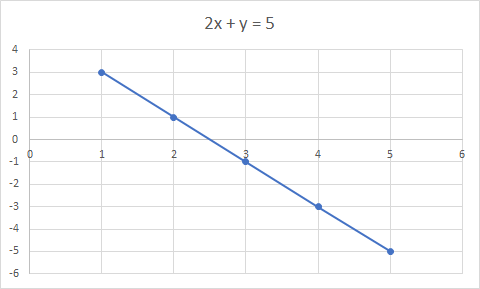A Linear Equation is an equation for a straight line. Example: 2x + y = 5 is a linear equation

The graph of 2x + y = 5 is a straight line
We can define a Linear Equation as:
Linear Equation is an Equation of degree 1 and hence represents a straight line on a graph. Linear Equations are also called as first degree equations, as the highest power of the variable in these equations is 1.
How do we say if an equation is linear or not? Let's understand this with a few examples given below.
Example:
Any equation has a degree. 2x +3y = 5 has three terms. The highest power of the variable in an equation is the 'degree'. Here is 2x, x has a power 1 i.e. x1. In 3y, y also is of power 1 i.e. y1, therefore this equation is a linear equation
In this equation, the degree of the term 5xy is two. x is of power 1, and y is of power 1 so the total degree, which is the summation of the power of all the variables of that term is 1 + 1 = 2. Therefore, this equation is not a linear equation.
In this equation, there are 5 terms but the degree of all these terms is 1, therefore this is a linear equation.
Here we learned that for a Linear Equation there is no limitation on a number of variables in the equation. The limitation is on the highest power that a term in an equation can have.
In this equation, the power of x is -1(x-1), hence this equation is not a linear equation.
A system of two consistent and independent equations in two variables is solved as follows:
Solve:
11x − 7y = 13
x − 7y = 3
Method:
To eliminate one of the unknown(step 1) following methods can be used:
Substitution method:
Let us solve the above equations using this method.
For
−7y = 13 − 11x
\(y = \frac{(13 - 11x)}{-7} \)
Substitute value of y in second equation.
x − 7y = 3
\(x - 7(\frac{13 - 11x}{-7}) = 3 \)
x + 13 − 11x = 3
−10x = 3 − 13
−10x =−10
Therefore, x = 1
as \(y = \frac{(13 - 11x)}{-7} \), substitute the value of x here and get the value of y
\(y = \frac{13 - (11 \times 1)}{-7}\)
\(y = \frac{13 - 11}{-7} \\ y = \frac{-2}{7}\)
Hence, x = 1 and y = −2 ∕ 7 is the required solution.
Elimination method:
Solve:
2x + 3y = 10
x + y = 6
Example 1: The sum of the digits of a certain two-digit number is 13 and the number is 2 more than 7 times the unit's digit. Find the numbers.
Let x be at the unit place and y at the tens place.
10y + x = the number=yx
y + x = 13
10y + x = 2 + 7x ⇒ 10y − 6x = 2
2(5y −3x) = 2 ⇒ 5y − 3x = 1 ⇒\( y = \frac{1 + 3x}{5}\) … using substitution method
y + x = 13 ⇒ \(\frac{1 + 3x}{5} + x = 13\)
1 + 3x + 5x = 13 × 5
1 + 8x = 65 ⇒ 8x = 64
x = 8, therefore y = 13 − x ⇒ y = 13 − 8 = 5
The number is 10 × 5 + 8 = 58 (Answer)
Example 2: The cost of 3 coffee tins and 2 tea packets is $15 and that of one coffee tin and 4 tea packets of the same type is $12. Find the cost of each.
Let the cost of one coffee tin is $x and for one tea packet is $y.
3x + 2y = 16
1x + 4y = 12
Use the elimination method,
+2x + 8y = 24
- - -
----------------
10x = 40
x = 4, therefore 4 + 4y = 12 ⇒ y = 2
The cost of one coffee tin is $4 and the cost of one tea packet is $2.(Answer)